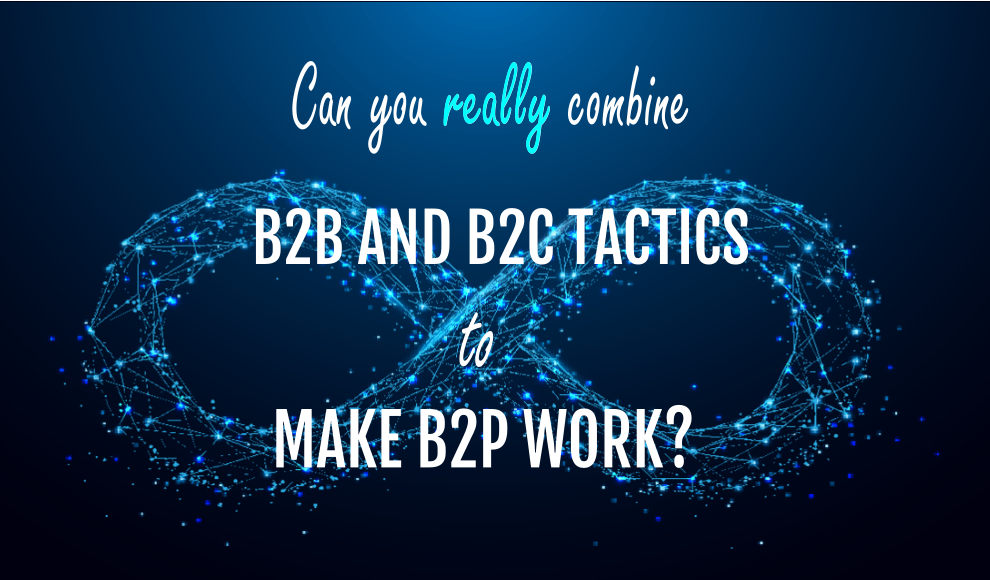Can you really combine b2c and b2b tactics to make b2p work?
As marketers we often can’t stop ourselves creating new concepts or themes to give some kind of validation for what we do. Or perhaps aspire to do. After all, we are in the business of aspirations, hopes, positivity, optimism, and calls to action.
Some of these have been translated into action with greater or less success. The focus on ABM and Customer Experience, for example, has enabled marketers to move from needs to processes and discipline that are driving measurable results.
But one proposition that has been left in limbo between a goal and a tried and tested strategy is b2p – “business to people” marketing.
What does it even mean? The idea dates back decades to direct mail copywriting when someone remembered that business people were, well, people, and need not be addressed or persuaded in formal language. B2b marketing had to remember, in a rather banal phrase, that you didn’t become a different person once you had stepped out of the office and crossed the domestic threshold or vice versa.
How quaint that sounds in the digital, post-pandemic world!
It is true that to some extent b2p has moved into the digital age. Content is more narrative-driven and often focuses on stories to deliver a message. Video plays a far greater role. And, of course messages can be much more personalized than ever before, aided by martech stacks that automate processes.
But what is missing is the orchestration of b2b account and contact-based segmentation with b2c true persona creation.
A b2b decision-maker or influencer can and should be engaged in ways that reflect their demographics, interests and behavior not just their responsibilities. Think across to the b2c world – the total market for a beverage brand might be large and diverse. But advertising and marketing segments that into different approaches based on research and testing.
From this research and testing a good understanding of the target audiences is driving the content development and the marketing channel choices.
Here is a case example:
Targeting IT managers in midsized companies.
They have wide-ranging demographics; however, through research it turned out that a large part of this target audience likes gaming. That could be a segment to approach with certain content and via particular channels. The content to target this segment of IT managers could include gaming. The targeting could take place within certain popular games of these IT managers. And a subsegment of this target group will even be active in virtual worlds (metaverses). An approach can be developed to target this subsegment in the metaverse through weaving the product and/or service into these virtual worlds or find a way to communicate your message there in an engaging way. E.g. by hosting a virtual event.
Now Demand Studio and HuHeHa have joined forces to develop a process to do this. It embodies a data-driven approach that works in seven stages:
Traditional ABM account segmentation
Contact level selection
Contact level enrichment
Persona creation
Persona and contact matching incorporating b2c attributes
Alignment of personas with media and message
Engagement
Looking at this another way, the different components act as multipliers until you have data, content, and media aligned to promote engagement. The end result is combining b2b and b2c data attributes to make b2p a real process. Communication is driven by who the prospect, what they do, what they like, the role they play, how they prefer to engage, and how they interact with the decision-making unit in their organization.

Here is how it can work:
Account Segmentation
Accounts are the basis of all ABM and b2b marketing, and must be selected on the usual criteria of firmographics, previous engagement, intent scores and so on
Contact Selection
Initially contacts should be selected based on their role within an organization and, if possible, previous interaction with sales or marketing
Contact Enrichment
This is where b2c begins to overlay b2b. As well as job function and job titles, enrich with social handles. Use the publicly available information that is shared on social media to add data on job history, demographics, activities, professional and personal interests. Some of this can be automated, but hands-on desk research, and, after development, modelling.
Here are some of the things to look for in the social profiles and activities of your prospects. Look at both information data and behavior online:
What do they post, like or share? Thought leadership content or something more technical and granular?
Level of activity on LinkedIn vs. Twitter vs. TikTok vs. Facebook
Age range derived from work experience or education dates
Type of content consumed – video, webinars, podcasts, articles?
Do they go to events, are they members of communities, do they have a strong network? If they do, think about how you can develop interactive assets and develop surveys, panels, and get them to join teams of experts.
How active are they on social media? Is there a subset of decision-makers and influencers that should be reached on Twitter, for example?
For international prospects, are they comfortable reading English or just their native language?
Do they have any personal hot-buttons or causes they are passionate about? (Here I would be careful and, rather than play to these, bear them in mind to exclude anything that might be regarded as offensive, however inadvertently.)
Persona Creation
Now you are in a position to develop personas that are based on individual characteristics as well as business qualifiers:

For example, you will now be able to create a persona that is of a mid-career technical influencer, who has responded to webinars and videos rather than downloaded white papers, and is in millennial age bracket.
Persona and Contact Matching
In order to operationalize this, match the persona with the business to create segments that is supported by messaging that can be truly personal
|
|
Persona A |
Persona B |
Persona C |
|
Account Segment |
Enterprise |
Mid-market |
Small |
|
Industry |
Manufacturing |
Finance |
Pharma |
|
Job Role |
Decision maker |
Influencer |
Decisionmaker |
|
Function |
IT |
Line of Business |
Management |
|
Seniority |
High |
Medium |
High |
|
Media Preference |
White Paper |
Video |
Webinar |
|
Business Interests |
Technical |
Operational |
Financial |
|
Personal Style |
Formal |
Edgy |
Practical |
Content Creation
Based on these insights and personas, content is being created that promises to be the most attracting and engaging for the segments targeted.
Media Alignment
The Media Preference, in conjunction with the buyer’s journey stage, will help to deliver the media channel likely to have the most impact on the prospect. As always, testing will inform the adaptation of personas and models.
Engagement
Now you have fully enriched b2p targets that combine both b2b criteria at the account and contact level and b2c characteristics that will together support positive engagement. Most marketers test content – but they do so across the board without differentiation between personas. But the impact of a visual image or medium choice is likely to be significantly different between personas.
How we can help
HuHeHa and Demand Studio bring together a unique combination of skill and expertise based on decades of experience with leading consumer and b2b brands. We will advise and consult on what needs to be done, and help you get it done.
About Demand Studio
Demand Studio provides a unique and global approach to planning, implementing and delivering integrated demand acceleration solutions.
You are at the center of what we do
Ø We align with your environment and sales and marketing goals
Ø Our holistic approach ensures that all pieces of a marketing engine are working together to drive revenue
The Alchemy of the right assets
Ø We have unrivalled access to marketing and data tools and assets – with an agnostic view so that we will select best of breed for your sales and marketing ecosystem and individual campaigns
A-Team and global scope
Ø A highly experienced team in B2B Marketing services
Ø Resources in data services and analytics, digital program execution and optimisation, program management and telemarketing operations
Ø Team will create, execute, and guide our clients through all programs we run
Ø Global, regional and local focus and experience
About HuHeHa
HuHeHa is a boutique advisory firm, founded by Hugo Hanselmann. HuHeHa’s mission is to help companies to master the magic triangle of strategy, marketing and innovation, enabling them to flourish in today’s digital world
Reach out to us at enquiries@demand-studio.com



